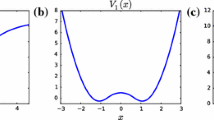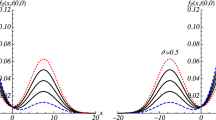Abstract
Sampling from probability distributions in high dimensional spaces is generally impractical. Diffusion processes with invariant equilibrium distributions can be used as a means to generate approximations. An important task in such an endeavor is to design an equilibrium-preserving drift to accelerate the convergence. Starting from a reversible diffusion, it is desirable to depart for non-reversible dynamics via a perturbed drift so that the convergence rate is maximized with the common equilibrium. In the Gaussian diffusion acceleration, this problem can be cast as perturbing the inverse of a given covariance matrix by skew-symmetric matrices so that all resulting eigenvalues have identical real part. This paper describes two approaches to obtain the optimal rate of Gaussian diffusion. The asymptotical approach works universally for arbitrary Ornstein–Uhlenbeck processes, whereas the direct approach can be implemented as a fast divide-and-conquer algorithm. A comparison with recently proposed Lelièvre–Nier–Pavliotis algorithm is made.



Similar content being viewed by others
Notes
Complex eigenvalues cannot be ordered. The continuous dependence of one particular eigenvalue and its associated eigenvector among other eigenpairs therefore has to be carefully discerned.
We remark that fitting these data with polynomials of higher degrees would be of little avail. It can easily be checked numerically that the coefficients associated with the higher degree terms are nearly zero.
References
Acker, A.F.: Absolute continuity of eigenvectors of time-varying operators. Proc. Am. Math. Soc. 42, 198–201 (1974)
Amit, Y.: On rates of convergence of stochastic relaxation for Gaussian and non-Gaussian distributions. J. Multivar. Anal. 38(1), 82–99 (1991)
Amit, Y.: Convergence properties of the Gibbs sampler for perturbations of Gaussians. Ann. Stat. 24(1), 122–140 (1996)
Amit, Y., Grenander, U.: Comparing sweep strategies for stochastic relaxation. J. Multivar. Anal. 37(2), 197–222 (1991)
Bhattacharya, R., Denker, M., Goswami, A.: Speed of convergence to equilibrium and to normality for diffusions with multiple periodic scales. Stoch. Process. Appl. 80(1), 55–86 (1999)
Chen, T.L., Hwang, C.R.: Accelerating reversible Markov chains. Stat. Probab. Lett. 83, 1956–1962 (2013)
Chen, T.L., Chen, W.K., Hwang, C.R., Pai, H.M.: On the optimal transition matrix for Markov chain Monte Carlo sampling. SIAM J. Control Optim. 50(5), 2743–2762 (2012)
Chu, M.T.: On constructing matrices with prescribed singular values and diagonal elements. Linear Algebra Appl. 288(1–3), 11–22 (1999)
Chu, M.T.: A fast recursive algorithm for constructing matrices with prescribed eigenvalues and singular values. SIAM J. Numer. Anal. 37(3), 1004–1020 (2000)
Chu, M.T., Golub, G.H.: Inverse eigenvalue problems: theory, algorithms, and applications. Numerical mathematics and scientific computation. Oxford University Press, New York (2005)
Cline, R.E., Plemmons, R.J., Worm, G.: Generalized inverses of certain Toeplitz matrices. Linear Algebra Appl. 8, 25–33 (1974)
Davis, P.J.: Circulant matrices. Pure and applied mathematics. A Wiley-Interscience Publication, New York (1979)
Franke, B., Hwang, C.R., Pai, H.M., Sheu, S.J.: The behavior of the spectral gap under growing drift. Trans. Am. Math. Soc. 362(3), 1325–1350 (2010)
Frigessi, A., Hwang, C.R., Younes, L.: Optimal spectral structure of reversible stochastic matrices, Monte Carlo methods and the simulation of Markov random fields. Ann. Appl. Probab. 2(3), 610–628 (1992)
Hermosilla, A.Y.: Skew-symmetric Gaussian diffusions. In: Proceedings of the Third Sino-Philippine Symposium in Analysis, Quezon City, 2000, Special Issue, pp. 47–59, (2000).
Hwang, C.R., Sheu, S.J.: On some quadratic perturbation of Ornstein–Uhlenbeck processes. Soochow J. Math. 26(3), 205–244 (2000)
Hwang, C.R., Hwang-Ma, S.Y., Sheu, S.J.: Accelerating Gaussian diffusions. Ann. Appl. Probab. 3(3), 897–913 (1993)
Hwang, C.R., Hwang-Ma, S.Y., Sheu, S.J.: Accelerating diffusions. Ann. Appl. Probab. 15(2), 1433–1444 (2005)
Kato, T.: Perturbation theory for linear operators. Classics in mathematics. Springer, Berlin (1995). Reprint of the 1980 edition
Kontoyiannis, I., Meyn, S.P.: Geometric ergodicity and the spectral gap of non-reversible Markov chains. Probab. Theory Related Fields 154(1–2), 327–339 (2012)
Lelièvre, T., Nier, F., Pavliotis, G.A.: Optimal non-reversible linear drift for the convergence to equilibrium of a diffusion. J. Stat. Phys. 152, 237–274 (2013)
Markowich, P.A., Villani, C.: On the trend to equilibrium for the Fokker–Planck equation: an interplay between physics and functional analysis. Math. Contemp. 19, 1–29 (2000)
Mengersen, K.L., Tweedie, R.L.: Rates of convergence of the Hastings and Metropolis algorithms. Ann. Stat. 24(1), 101–121 (1996)
Metafune, G., Pallara, D., Priola, E.: Spectrum of Ornstein–Uhlenbeck operators in \(L^p\) spaces with respect to invariant measures. J. Funct. Anal. 196(1), 40–60 (2002)
Mira, A.: Ordering and improving the performance of Monte Carlo Markov chains. Stat. Sci. 16(4), 340–350 (2001)
Pai, H.M., Hwang, C.R.: Accelerating Brownian motion on N-torus. Stat. Probab. Lett. 83, 1443–1447 (2013)
Roberts, G.O., Rosenthal, J.S.: Variance bounding Markov chains. Ann. Appl. Probab. 18(3), 1201–1214 (2008)
Sramer, O., Tweedie, R.L.: Geometric and subgeometric convergence of diffusions with given distributions, and their discretizations. (1997). Unpublished manuscript
Taussky, O.: Positive-definite matrices and their role in the study of the characteristic roots of general matrices. Adv. Math. 2, 175–186 (1968)
Trefethen, L.N., Bau III, D.: Numerical linear algebra. Society for Industrial and Applied Mathematics (SIAM), Philadelphia (1997)
Villani, C.: Hypocoercivity. Mem. Am. Math. Soc. 202, (2009)
Acknowledgments
This research was supported in part by the National Science Foundation under Grant DMS-1014666.
Author information
Authors and Affiliations
Corresponding author
Rights and permissions
About this article
Cite this article
Wu, SJ., Hwang, CR. & Chu, M.T. Attaining the Optimal Gaussian Diffusion Acceleration. J Stat Phys 155, 571–590 (2014). https://doi.org/10.1007/s10955-014-0963-5
Received:
Accepted:
Published:
Issue Date:
DOI: https://doi.org/10.1007/s10955-014-0963-5




